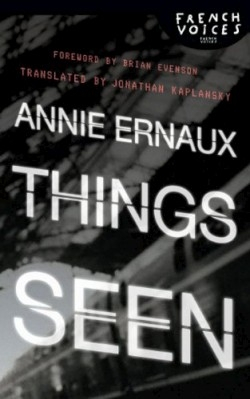Things Seen
Things Seen is a slender volume of essays, so slim for a book-length work that it might be mistaken for, at a first glance, a novella or a poet’s chapbook. Though brief, the French writer Annie Ernaux’s most recent book weighs in, through an intimate epistolary form, on love, war, politics, and relationships, all through the provoking focus of Ernaux herself. Translated by writer Jonathan Kaplansky, Things Seen (La Vie Extérieure) takes as its subjects the strange faces of Paris and the surrounding suburbs; Ernaux watches these strangers on the trains to and from the city, and her keen observations drive the narrative with wit and a sharp taste for tragedy. Her intention: to uncover moments of profound realization among these everyday commutes of everyday Parisians. “I write…everything I write here,” she asserts, “as evidence.” Like a poet, Ernaux writes with dense, image-packed language; like a novelist, she seeks compelling characters to appear and disappear throughout her text.
Moments of interior humor fleck Things Seen; in one entry, Ernaux hides bread behind cat litter at her local supermarket, imagining “hundreds of products abandoned all over the place, deli meats left in the shoes…” Overall, however, this collection finds its most profound moments in the tragic, shadowing the book with meditative sadness. On the oft-crowded RER trains, Ernaux observes the homeless, the lonely, and the misguided; she offers little optimism for their plights, noting instead the seeming permanence of their sorrow and the indifference of those more fortunate. Violence—of war, of daily life—appears in Things Seen as a sort of thematic backdrop. “Yesterday,” she writes in an entry dated July 26, 1995, “a bomb exploded in the RER…in a month, we’ll be waiting on that platform where bodies were pulverized as if nothing had happened.”
Things Seen‘s diaristic structure, and the closeness it affords between reader and writer, suits this collection’s lyric intimacy; as we move through Ernaux’s private musings and realizations, we feel acutely immersed in her emotional world. “The interpretations of reality are practically infinite,” she writes, and fortunately for us, hers is captured here—and translated beautifully by Kaplansky, who leaves just enough (places, cultural markers, foods) in French to give an American reader the romantic feeling of the original language without obscuring the meaning of the text.
Disclosure: This article is not an endorsement, but a review. The publisher of this book provided free copies of the book to have their book reviewed by a professional reviewer. No fee was paid by the publisher for this review. Foreword Reviews only recommends books that we love. Foreword Magazine, Inc. is disclosing this in accordance with the Federal Trade Commission’s 16 CFR, Part 255.

